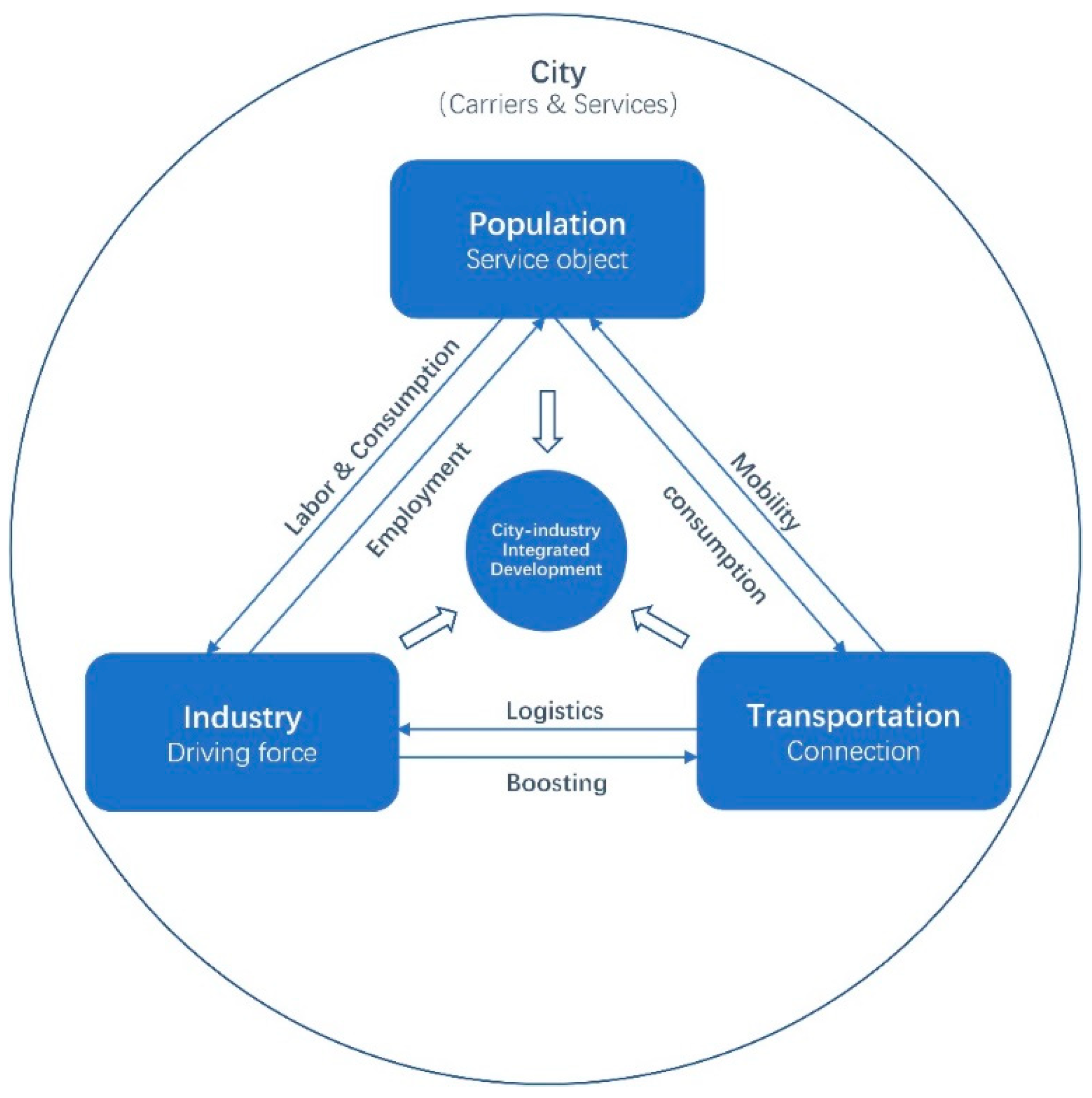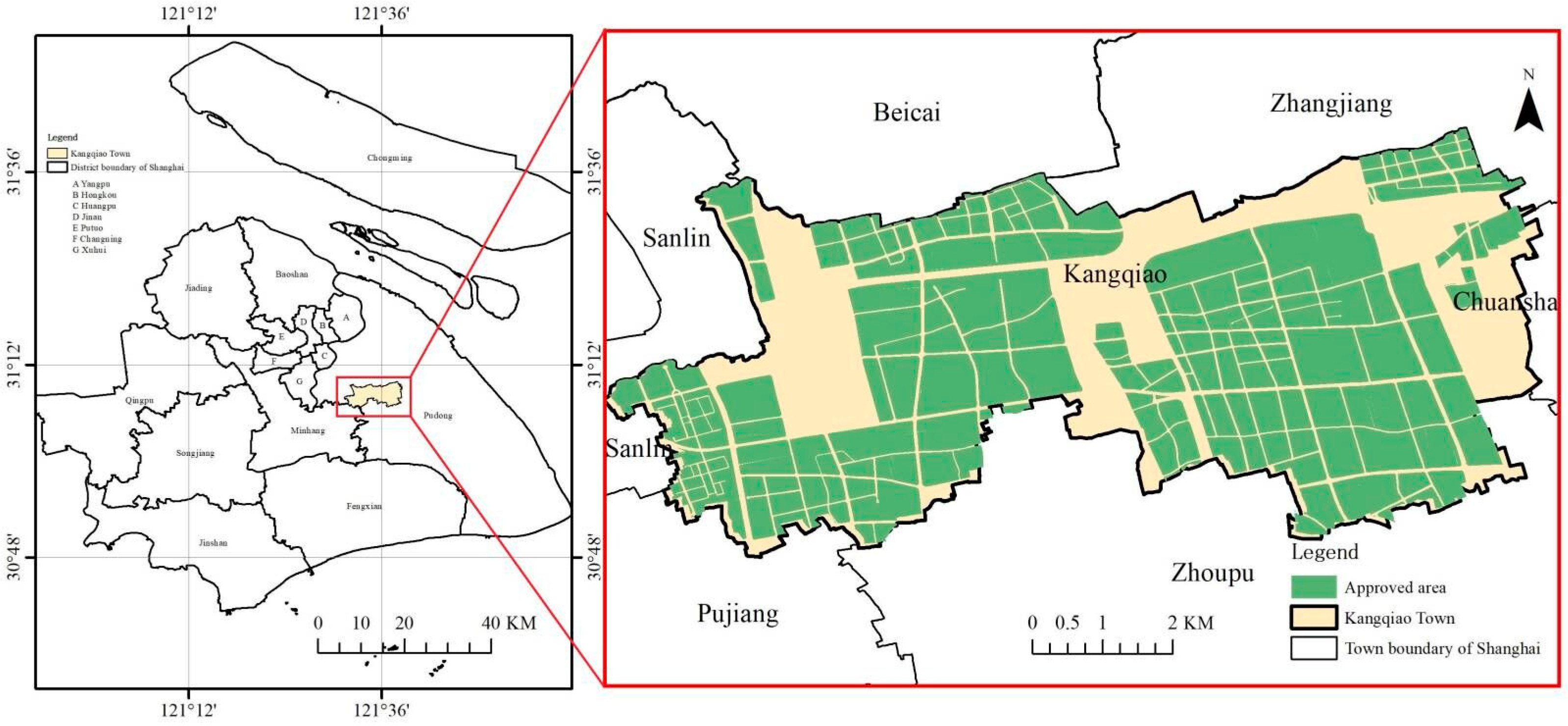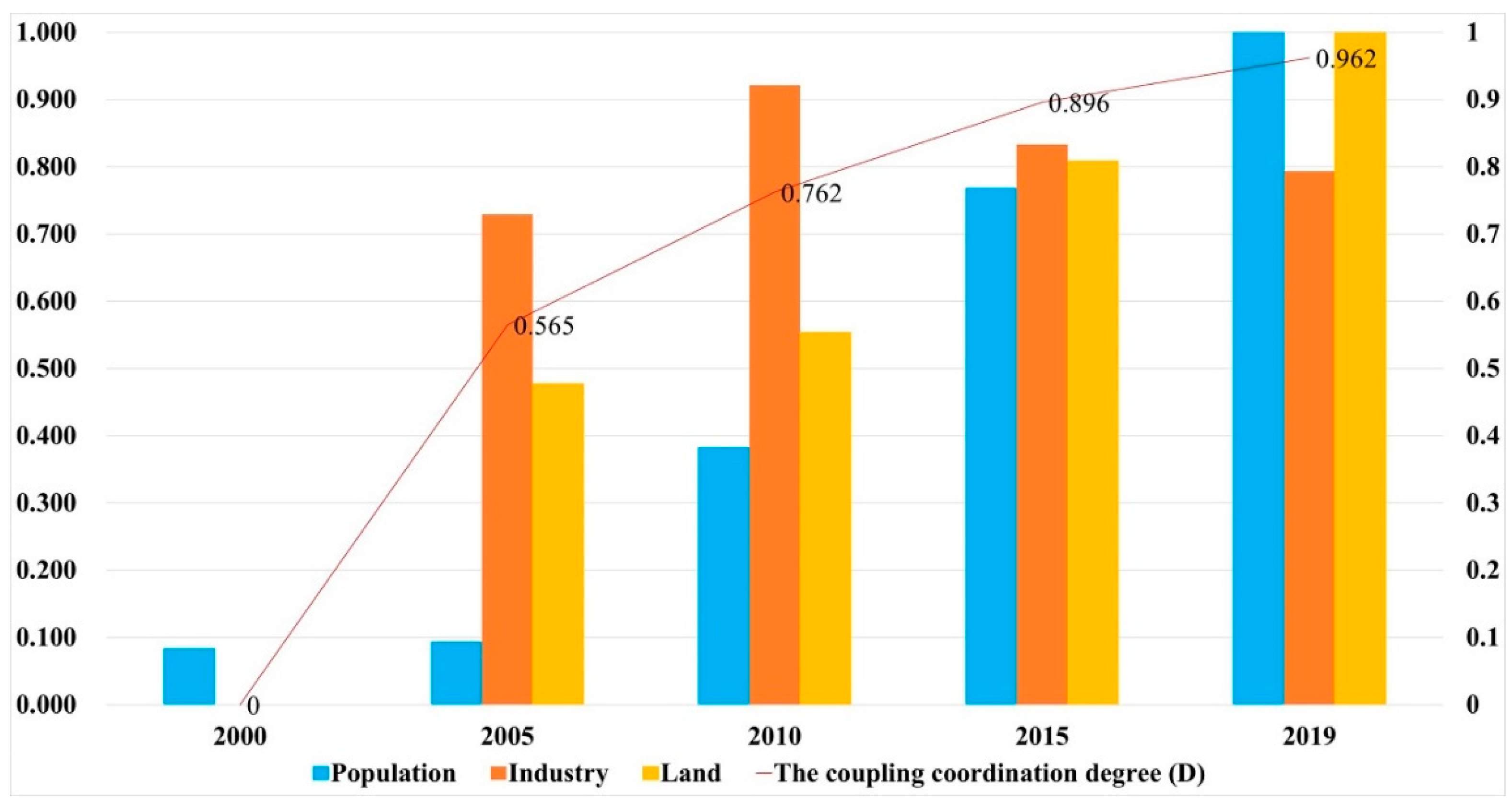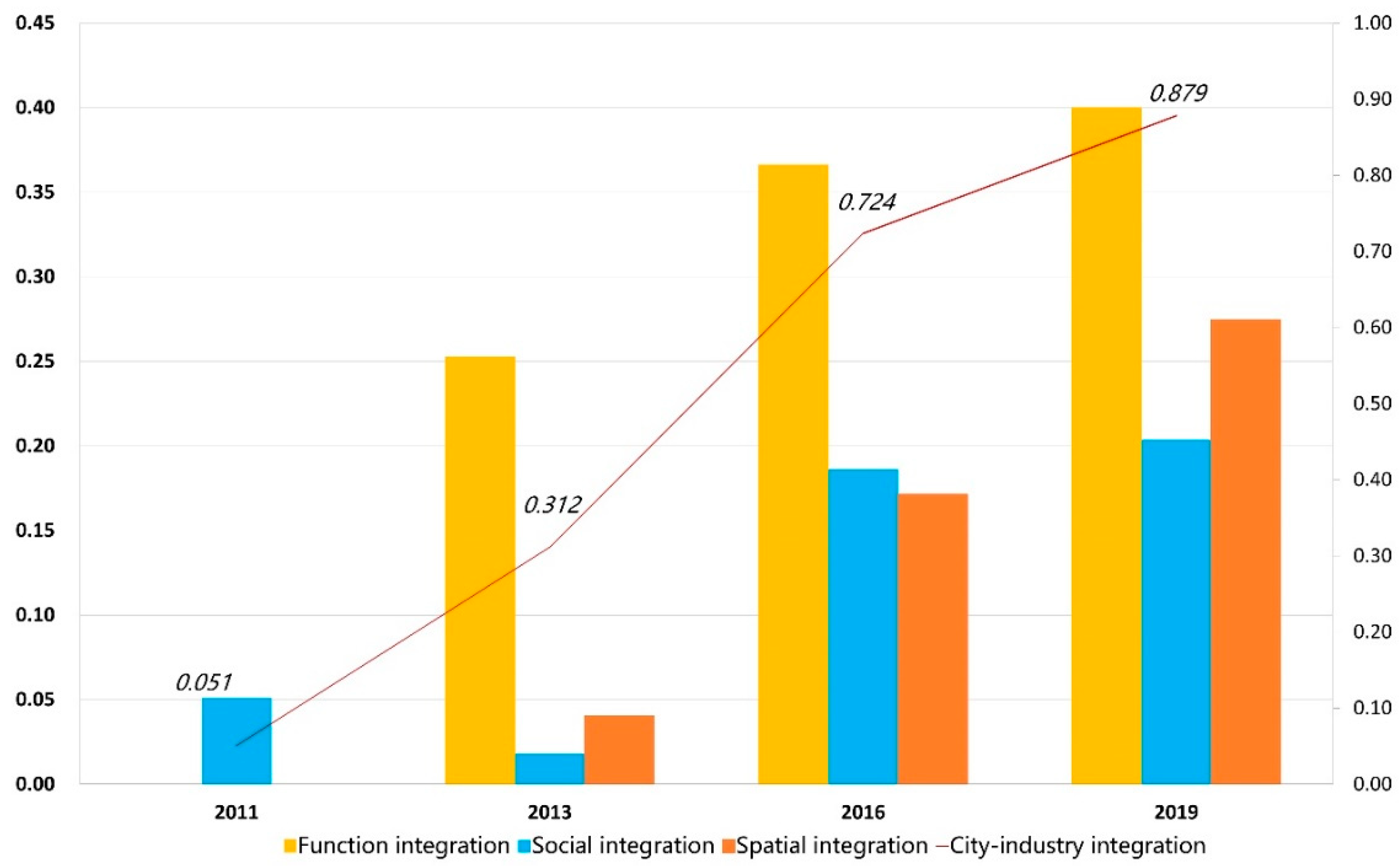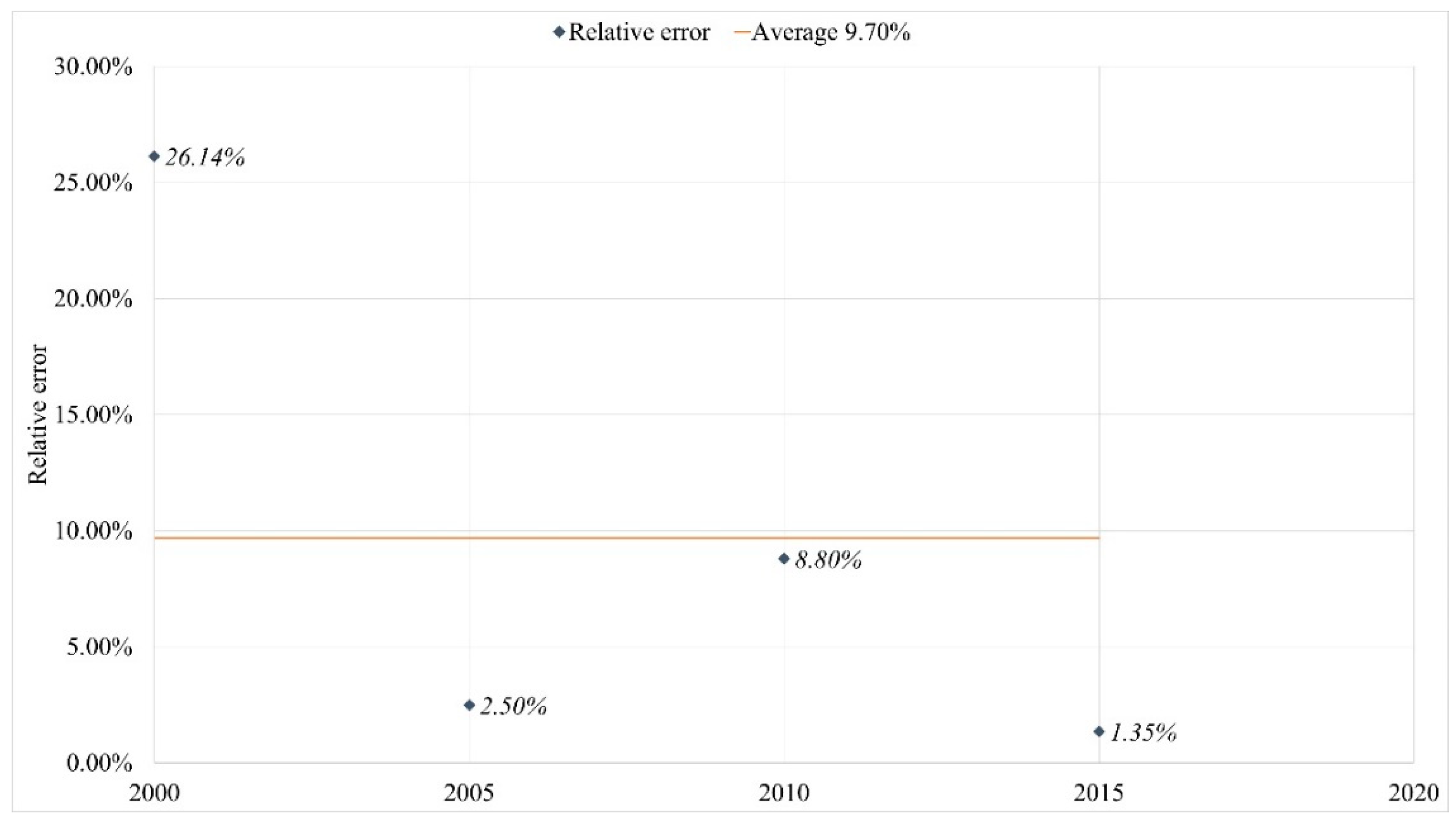1. Introduction
The coordinated development of industry, city, and population has always been the goal of urban planners. How do we understand the connotations and essence of the integrated development of city and industry from different spatial scales? How do we evaluate the level of the integrated development of city and industry dynamically? These are two core problems in the study of the integrated development of city and industry.
The city is the organism of system integration, including population concentration, industrial agglomeration, infrastructure allocation, and public service supply. The process of urbanization is an interactive development process involving the population structure, industrial structure, residential structure, and land-use structure under certain time and space conditions. The planning and construction of early garden cities, satellite cities, and industrial suburbs aimed to achieve the integration of urban and rural space development [
1,
2,
3]; although spatially separated from the metropolitan built-up areas, its strong economic and social self-sufficiency is still emphasized. Later, as a specific area in the expansion of the central city, new towns or new cities began to be planned and constructed [
4,
5,
6,
7,
8], which was also aimed to relieve the over-dense population and employment of the central city, and led to the rise of greenbelt cities, edge cities, and technical suburbs [
9,
10]. Citizens exist within a complete living environment that integrates work, life, and entertainment, so the layout of the factory must take into account the relationship between the factory and the residential area [
11]. In addition to industrial suburbs, residential suburbs, commercial suburbs, and information suburbs have also emerged. Whether it is “modern urbanism” advocating for urban concentration, increasing green space areas, and optimizing the transportation network, or “new urbanism” advocating for the mixed-use of land and space, both involve city–industry integration or urban–rural integration to a certain extent [
12,
13]. This evidence suggests that the scope of city–industry integration has gradually expanded from new towns or technical suburbs to the urban scale. Unfortunately, these new towns or technical suburbs are far less attractive to industries and talent than the central cities. As a result, there is a job–housing imbalance or uncoordinated industrial and urban development between the central city and the suburbs.
On the whole, academic research on city–industry integration mainly involves the following aspects:
(1) Research on the connotations and essence of city–industry integration. In developed western countries, there is no explicit concept of city–industry integration development. However, there are studies in the field of urbanization and industrialization related to the concept of city–industry integration [
14], including a causal relationship between industrialization and urbanization [
15], a positive effect of urban development on industrial-scale returns, and the promotional effect of industrial agglomeration on urban development [
16,
17]. The upgrading of the industrial structure and industrial diversification are the main drivers of the sustainable development of urbanization [
18]. City–industry integration refers to the interactive evolutionary relationship between industrialization and urbanization, which may exist in three forms: over-urbanization (i.e., urbanization leads while industrialization lags, also known as the “city before production” model), under-urbanization (i.e., industrialization leads while urbanization lags, also known as the “production before city” model), and simultaneous urbanization (i.e., coordinated development of industrialization and urbanization or integrated development of city–industry) [
19,
20,
21,
22,
23,
24,
25,
26]. However, it should be noted that industrialization and urbanization not only have significant spatial differences but also have distinct stage differences. In the initial stage of economic development, it may be reasonable that the level of industrialization is higher than that of urbanization; in the post-industrialization period, it is normal that the level of urbanization is higher than that of industrialization. In other words, industrialization and urbanization are not always synchronized at different stages of economic development.
In China, city–industry integration refers to the degree of alignment between the industrial structure and urban functions in new urban areas or industrial parks, and dissonance between the two is reflected in the separation of city and industry [
27,
28,
29]. Along with the expansion of the study area, the focus of city–industry integration has gradually moved from a pure city–industry relationship to further encompass the development of the main body of the city—the people themselves, i.e., the integrated development of industry, city, and people [
14,
30,
31]. At the same time, the development of urban rail transport has also led to a focus on transport and accessibility [
7]. In a broad sense, city–industry integration covers economic integration, social integration, cultural integration, industrial integration, ecological integration, functional integration, and spatial integration. The essence of city–industry integration is the integration of residence and employment and the integration of urban communities and industrial parks.
(2) Research on the characteristics and driving mechanisms of the city–industry integration. “Industry” includes manufacturing, the service industry, and various related industrial forms; “city” refers to the urban agglomeration of various functions, such as regulation, production, coordination, and services [
32]. Moreover, the ideal city–industry integration has the characteristics of a symbiosis between urban function and industrial layout, the coexistence of life and employment, the interaction between the manufacturing and service industry, and harmony between economy and environment. Its driving forces include economic, institutional, socio-cultural, technological, and biophysical drivers. The evolution of city–industry interaction is an inherent mechanism for the high-quality development of new urban areas. An increase in the degree of city–industry integration can significantly promote regional innovation development; compared to the path of “industry before city”, the path of “city before industry” has a more pronounced role in promoting regional innovation [
33]. The underlying mechanism for the coordinated development of industries and cities depends on the people and services that connect them [
34,
35]. Overseas scholars pay more attention to the environmental effects of industrialization and urbanization [
8,
36] or the planning and construction of eco-industrial parks [
37,
38]. It should be pointed out that peri-urbanization [
39,
40,
41,
42] is a necessary stage of urban expansion, which is caused to a greater extent by institutional or government policies, especially in developing countries. Additionally, urban shrinkage is the result of deindustrialization, suburbanization, industrial transformation, and changes in the population structure [
43,
44,
45,
46]. The essence of shrinking cities is the weakening of growth drivers, the loss of jobs, and a decrease in the financial revenue of cities, caused by the decline of their traditional leading industries. The main reason for the decline of traditional leading industries lies in the lag in the shift from old to new drivers and the transformation from scale expansion to quality and efficiency improvement. In a sense, this is also a consequence of the serious imbalance between cities and industries.
(3) Measurement method for the degree of city–industry integration. With the depth of research, the study of city–industry integration has gradually developed from qualitative analysis to quantitative research. Scholars tend to consider city–industry integration as a state or process of urban development and choose different indicators for evaluation, specifically using methods such as factor cluster analysis, fuzzy hierarchical analysis, principal component analysis, grey correlation analysis, and the entropy method [
29,
32,
47,
48,
49,
50]. However, most of these studies focus on a certain point in time and are strongly dependent on statistical data. Recently, based on the urban population–industry system, some scholars have used the coupling coordination degree to quantitatively evaluate the level of city–industry integration and identify its spatial-temporal pattern and the key impacting factors [
51,
52]. This provides a reference for research on the multi-temporal development of city–industry integration. However, due to the lack of a profound understanding of the internal mechanism of city–industry integration, the evaluation indicators that are selected are either too numerous or too arbitrary, or there is an excessive reliance on statistical data, which contain statistical bias caused by subjective feelings and sample selection. Moreover, statistical units are often of a large regional scope, which makes it difficult to obtain data of fine scope, etc. Because the integrated development of city and industry is the result of the interaction between population and industry in space, some important data related to space often cannot be obtained directly and need to be obtained indirectly by means of geo-computing methods. At the overall level of the city, the statistical data are relatively rich; however, at the level of industrial parks and even plots, statistical data are relatively scarce, and need to be supplemented by spatial data. Some indicators that are readily available are often unimportant, while those that are important are often difficult to obtain.
(4) Research on the modes and paths of city–industry integration. Researchers have regarded city–industry integration as a policy tool, or a means and a goal of healthy urban development, and focused on practical problems such as the imbalance between urbanization and industrialization, the mismatch between urban function and industrial layout, and the imperfect government function and operation mechanism. They have proposed the development modes, paths, and tactics of new city or new town construction [
53,
54,
55,
56,
57], including structure optimization, function upgrading, industrial upgrading, transportation organization, supporting facilities, urban landscape construction, low-carbon development, etc. However, some studies have ignored the organic combination of new-town construction and old-city renewal or the interactive development between industrial parks, university campuses, and urban communities [
30]. The living needs of migrant workers and the rationality of land use in industrial parks have not received enough attention.
In summary, the following problems are noted in the existing studies: (1) the concept of city–industry integration is vague and diverse, and its internal mechanism is not fully understood; (2) the multi-scale nature of city–industry integration is not appreciated; (3) there is a lack of evaluation of long time-series of city–industry integration; and (4) there is an over-reliance on statistical data, which has led to a lack of spatial and population mobility perspective in the existing evaluation system.
Therefore, aimed at the above problems, the purposes of this study are: (1) to understand the connotations and essence of the integrated development of city and industry from different spatial scales, (2) to introduce the spatial perspective into the evaluation system, with multi-source geospatial data, and (3) to evaluate it dynamically.
The contributions of this paper are as follows: (1) a theoretical framework (C-PIT model) is constructed to analyze city–industry integrated development; (2) three dimensions (functional integration, social integration, and spatial integration) and their index systems are proposed to measure the level of city–industry integration at the industrial park scale; (3) a multi-temporal dynamic evaluation of city–industry integration is conducted. The proposed methodology of this paper can be used as a reference for similar research in developing large cities with advanced industrialization and lagging urbanization.
The remainder of this paper is organized as follows.
Section 2 introduces methodology of this research, including: (i) Definition of city–industry integration on the city scale and the industrial park scale; (ii) C-PIT theoretical model; (iii) Evaluation index system of city–industry integrated development; and (iv) Case study approach.
Section 3 is an empirical analysis of Shanghai and an industrial park in Shanghai.
Section 4 discusses the results of the case study, including a comparative discussion of the results from other studies.
Section 5 reports on the main conclusions.
4. Discussion
Based on the evaluation system of the C-PIT model, this research demonstrates the development patterns of city–industry integration in the two cases of Shanghai and the Kangqiao Industrial Park. Compared with existing studies, this study adds a spatial perspective to the evaluation system. This section will discuss the reliability and innovation points of this study by comparing the findings with previous studies. The reliability of the data processing methods, the limitations of this study, and policy recommendations will also be discussed in this chapter.
4.1. Comparative Analysis
At the city level, the results of this study also show that the degree of city–industry integration in Shanghai has generally shown an upward trend over the past 20 years. Previous studies also found that, since 2000, the level of city–industry integration development in Shanghai has consistently occupied a leading position within China [
63,
85]. However, unlike the increasing trend of integration exhibited by population and land, the degree of industrial integration shows fluctuations in this study. The change in the industrial integration degree in Shanghai is consistent with previous research findings and can be traced practically.
Gan et al. [
52] conducted an empirical analysis of panel data of 18 cities in Sichuan Province from 2000 to 2016 to analyze the development process. They found that the key constraint was the development level of the industry subsystem. Other research also reveals the fact that the degree of city–industry integration will not remain unchanged after reaching a certain level. Liu et al. [
33] conducted a study on 285 prefecture-level cities in China and found that city–industry integration has an inter-industrial difference in shaping the industrial structure, with a neutral effect on the secondary industry and an encouraging effect on the tertiary industry. If the promotional effect of city–industry integration on the secondary industry fails, it will inevitably bring about the adjustment of the industrial structure. This inevitable obstacle in the urban transition period will cause the city to experience the fluctuation phenomenon in the degree of city–industry integration.
Practically, since China joined the WTO in 2001 and established Shanghai’s “Four Centres” development strategy in 2009, Shanghai’s industrial structure has undergone great changes, and a single industrial hub was transformed into a diversified economic hub. Although Shanghai is still one of the most important manufacturing centers in China, the service economy has taken up a dominant position in Shanghai’s economy. In 2019, Shanghai’s service industry accounted for 72.7% of the GDP, and industrial output accounted for 27% of the GDP.
At the industrial park level, most studies are qualitative and lack a quantitative evaluation system for industrial parks. Therefore, the correlation between the results of the coupling coordination degree calculation and the evaluation results of the industrial park’s city–industry integration were tested, and the correlation coefficient value between the two was 0.992, showing a significance level of 0.01, thus, indicating a significant positive correlation between the two. Both evaluation results show that the development level of city–industry integration in Kangqiao industrial park has a positive development trend (
Table 11). When the coupling coordination degree is greater than 0.5, the evaluation results of this paper show higher values; when the coupling coordination degree is less than 0.5, the evaluation results of this paper show lower values. In the future, with more data samples, it can be further explored whether this method has the advantage of expanding the variability of the stages of city–industry integration.
4.2. Data Validity
In addition to the relevant economic indicators, the spatial distribution characteristics of the industrial land-use structure also show corresponding changes. We compare the ratio of residential land to industrial land in each administrative district of Shanghai from 2000 to 2019 and calculate its Gini coefficient (
Table 12). The results show that the ratio of residential land to industrial land has increased significantly in the central urban areas and shown a decreasing trend in the suburban areas during the past 20 years, and the uneven distribution within the city has increased. The industrial land in Shanghai shows a clear trend of shifting from urban to suburban areas. The overall industrial structure of Shanghai is adjusting from the secondary industry, which is mainly manufacturing, to the tertiary industry, which is mainly financial, scientific, and creative services. This development trend is consistent with the stable state after the completion of industrial restructuring, as reflected in the industrial perspective of this paper.
Due to the access limitations of statistical data, this paper uses the resident population to represent the nighttime population and the employed population (secondary industry and tertiary industry) to represent the daytime population. Based on the correspondence between industries and related land use, the number of employees in each industry in each district is assigned to each area according to the type of land use. The results of this paper are compared with the available statistics on the number of employees in the administrative districts (2000, 2005, 2010, and 2015), and the relative errors are calculated for verification (
Figure 5).
Figure 5 shows that the average error of population estimation for the four specific years is 9.70%, among which the errors of estimation for three years are less than the average error, and the error of estimation for 2000 is higher than the average error, with a maximum error of 26.14%. The year with the largest error in population estimation is 2000, which is probably since the land allocation for the early industries in the Pudong New Area preceded the population inflow.
4.3. Limitations
The limitations of this paper are as follows. (1) On the city scale, the characteristics and paths of city–industry integration will be different for cities with different natures and functions. As a comprehensive metropolis, the evaluation ideas and methods of city–industry integration in Shanghai may be different from those of small- and medium-sized specialized cities, which need to be further studied. (2) On the industrial park scale, the comparative study of different types of industrial parks needs to be further strengthened. In China, there are various industrial parks, economic and technological development zones, high-tech development zones, and export processing zones. Although their common characteristics include obvious industrial advantages and a single function, especially a weak social service function, there are still some differences among them. (3) There is no empirical study on the development mode of new cities or new towns (i.e., “city before production” mode), such as Songjiang New City and Anting New Town in Shanghai, and there is no comparative analysis between the “production before city” mode and the “city before production” mode. This paper mainly focuses on the “production before city” mode, and it neglects the “city before production” mode. At present, Shanghai is carrying out the planning and construction of “five new cities” (Songjiang, Jiading, Qingpu, Fengxian, and Nanhui New Cities) [
86], and the model of “city before production” exhibits great research potential, which also shows that the theory of city–industry integration development has broad application prospects. Improving the theoretical system and methodology of the city–industry integrated development through more empirical studies is an important academic goal for the future.
4.4. Policy Recommendations
At the city scale, the policy focus of city–industry integrated development is (1) integrating high-quality housing, leisure, and recreational facilities into the commercial centers and sub-centers; (2) building more office space, shopping space, and leisure and entertainment space close to homes along major traffic routes to reduce the need for transportation. Simply increasing the density can render cities more efficient, but it cannot make them livable. By fully paying attention to the internal relationship between scale, size, density, distance, land, and industry, and better-integrating happiness into work, life, travel, and leisure and entertainment services, a livable city with the integrated development of industry, city, and people will be achieved.
At the industrial park level, attention should be paid to the coordinated allocation of land for public service facilities. The investigation and analysis show that the shortages of commercial land, educational facilities land, and public open space are the main restricting factors for the city–industry integrated development in Kangqiao industrial park. Excellent public open space can improve residents’ psychological or spiritual well-being. Strong social networks are associated not only with residents’ trust and life satisfaction but also with their sense of belonging. In future planning, the scale of these three types of land needs to be appropriately increased, but the construction of high-end villas should be controlled. Of course, to give full play to the utility of supporting facilities, mixed land use should be rationally planned. The increase in single-use land makes it difficult to increase the degree of the regional city–industry integration. Only by coordinating the allocation of various supporting facilities can the degree of the regional city–industry integrated development be effectively improved.
In addition, to deepen the city–industry integrated development, more attention should be paid to social integration. Social integration is not only an integral part of the city–industry integrated development but also an inevitable requirement for the construction of a happy city. Cities are aggregates of different races and social classes. Integrating family integration, ethnic integration, social class integration, and community integration into the city–industry integrated development is conducive to promoting the integrated development of residential communities, industrial parks, public activity areas, and urban areas.
It is worth noting that Marne Lavalle, a suburban new town in Paris, France, is the most successful of the five new towns in Paris. In its planning and construction process, in addition to fully considering the integration of housing, employment, and service functions, it also benefits from the healthy development of Discat Science City and Disneyland. Kangqiao town is now a part of Zhangjiang Science City and is adjacent to Shanghai Disneyland, which brings new opportunities to the Kangqiao industrial park. The Kangqiao industrial park can learn from the experience of Marne Lavalle so as to better exploit this special development opportunity, strengthen its ties with Zhangjiang Science City and Shanghai Disneyland, further improve the level of the city–industry integrated development, and promote the transformation of the Kangqiao industrial park into a new science and technology city.
